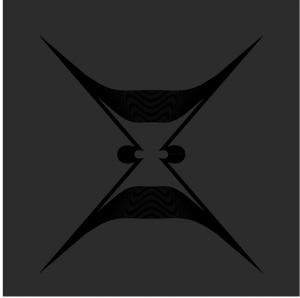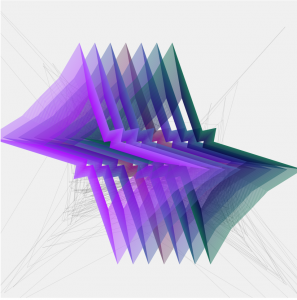var nPoints = 100;
function setup() {
createCanvas(480, 480);
}
function draw() {
background(60);
//in this for loop, we draw the bakcground element of the randomized curve
push();
translate(width / 2, height / 2);
for (r = 0; r < nPoints; r ++) {
stroke(200);
drawRandomDevil(r);
}
pop();
//in this loop, we draw the primary forground element
//which is the center devil's curve
push();
translate(width / 2, height / 2);
rotate(mouseX / mouseY);
for (v = 0; v < nPoints; v ++) {
stroke(mouseX - 200, v, mouseY - 300);
drawDevilBoi(v);
}
pop();
//this loop is to create the six rotating deveil's vurves
for ( c = 0; c < 6; c ++) {
push();
translate(width / 2, height / 2);
rotate(radians(60 * c));
translate(width / 4, height / 4);
rotate(mouseX / mouseY);
for (v = 0; v < nPoints; v ++) {
stroke(mouseX - 100, v, mouseY - 100);
drawDevilBoi(v);
}
pop();
}
}
function drawDevilBoi (x) {
//draw the devil's curve in this function
//first declare all the variables
var x;
var y;
var c = constrain((mouseX / width), 0, 1);
var co = constrain((mouseY / height), 0.0, 1.0);
var a = c * ((mouseX - 200) / 3 * (100 + v) / 100);
var b = co * ((mouseY - 200) / 3 * (100 + v) / 100);
//set desire stroke
noFill();
strokeWeight(0.25);
//draw the curve
beginShape();
for (var i = 0; i < nPoints; i += 5) {
var t = map(i, 0, nPoints, 0, TWO_PI);
x = cos(t) * sqrt ((pow(a, 2) * pow(sin(t), 2) - pow(b, 2) * pow(cos(t), 2)) / (pow(sin(t), 2) - pow(cos(t), 2)));
y = sin(t) * sqrt ((pow(a, 2) * pow(sin(t), 2) - pow(b, 2) * pow(cos(t), 2)) / (pow(sin(t), 2) - pow(cos(t), 2)));
vertex(x, y + 10);
}
endShape(CLOSE);
}
function drawRandomDevil (x) {
//draw another devil's curve, this time there is an element of randomness with it
var x;
var y;
var c = constrain((mouseX / width), 0, 1);
var co = constrain((mouseY / height), 0.0, 1.0);
var a = c * ((mouseX - 200) / 3 * (100 + r) / 100);
var b = co * ((mouseY - 200) / 3 * (100 + r) / 100);
//set the desired stroke
noFill();
strokeWeight(0.075);
//start to draw the curve
//this curve will be in the background and looks like noise
beginShape();
for (var i = 0; i < nPoints; i += 7) {
var t = map(i, 0, nPoints, 0, random(radians(350, 360)));
x = cos(t) * sqrt ((pow(a, 2) * pow(sin(t), 2) - pow(b, 2) * pow(cos(t), 2)) / (pow(sin(t), 2) - pow(cos(t), 2)));
y = sin(t) * sqrt ((pow(a, 2) * pow(sin(t), 2) - pow(b, 2) * pow(cos(t), 2)) / (pow(sin(t), 2) - pow(cos(t), 2)));
vertex(x, y + 10);
}
endShape(CLOSE);
}
This project was a bit of a mixed bag for me, as I did struggle to implement the curve into my work at first and make it appear in a way that I wanted it to. (Also choosing the curve I wanted to pursue took me a while, but I ultimately settled on The Devil’s Curve because I thought that it’s shape was very unique and could produce some nice variation). However, once I figured that out and began to play around I really enjoyed myself. I never really knew what changing the variables would make my code look like, so it was an exciting process of trial and error to create a nice form.




![[OLD FALL 2018] 15-104 • Introduction to Computing for Creative Practice](https://courses.ideate.cmu.edu/15-104/f2018/wp-content/uploads/2020/08/stop-banner.png)